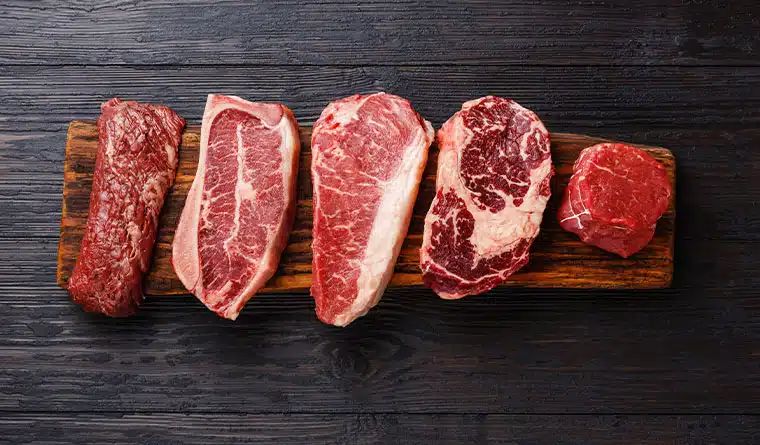
A Short Guide to Choosing Sustainable Proteins (Without Giving Up Your Love of Meat)
How do we calculate the “sustainability” of proteins?
Thanks to the use of Life Cycle Assessments (LCAs) for different foods, and companies like Klimato that make it easy to compare and understand what this means, we now have reliable ways to determine the sustainability of various foods. We can measure key indicators, such as greenhouse gas (GHG) emissions, water use or land use, associated with growing or producing a specific food. Then, we can use these measurements to objectively compare one protein source against another.

The Least Sustainable Proteins
For fairness sake, it’s important to remember that all proteins have an environmental impact. It’s just that some proteins have an out-sized environmental impact. Take traditional lamb and beef for example. Nutritionally-speaking, both are excellent sources of protein containing the full complement of amino acids essential for human health. However, they are also the least sustainable sources of protein.
According to Klimato, “it’s not a big surprise for anyone that meat has the highest carbon footprint of any component. Meat from beef herds has the highest carbon footprint of common foods, given the very low efficiency of calories consumed to calories produced, and their production of methane gasses.”
The amount of water required to produce one kilogram of protein is another way to assess its “sustainability”. Raising livestock for beef consumes approximately 15,000 liters of water (the equivalent of taking 187 baths!). Compare that to 1 Kg of chicken meat which uses 4,000 liters of water, and 1 Kg of soy which needs only half of that.
Regarding factory-farmed beef, additional factors contribute to its sustainability — or lack thereof. These encompass deforestation for pasture creation, the potential for antibiotic resistance (a real threat to human health), and water pollution from manure leakage, among others.
What are Sustainable Proteins?
Sustainable Proteins are protein sources whose environmental impact is lower compared to traditional animal-based proteins. “Sustainable proteins” are good for your health, the health of our growing global population and the health of our planet. Here’s our run-down of the top Sustainable Proteins.
Plant-Based Proteins
These are proteins derived from legumes, grains, nuts, and seeds and include soy, peas, lentils, quinoa, and chia seeds. Cultivation of plant-based proteins requires fewer resources (water, land, and energy) and emits lower quantities of greenhouse gasses. As such, they’re among the most affordable and sustainable proteins in the world. Legumes are star-performers as they are also great at absorbing the atmosphere’s nitrogen. This means they require less or no chemical fertilizers which are key contributors to water and air pollution, and feed back into the soil and boost its fertility.
Insects
Not the first protein source that comes to mind, and still not the most appealing or palatable to certain cultures, insects – like crickets, mealworms, and grasshoppers – are rich in protein, vitamins, and minerals, and are highly efficient at converting feed into protein. They can be farmed on organic waste, making them a sustainable alternative.
Algae and Seaweed
Microalgae and seaweed are highly sustainable sources of protein. They grow rapidly, can be cultivated in various environments (including marine settings), and have a high protein content along with essential amino acids, vitamins, and minerals .
Soy
Soy is such a popular plant protein worldwide, it has its own spot on our list. Its popularity comes from its nutritional value, versatility, and sustainability compared to animal protein. Soy production requires significantly less water, land and energy than animal-based proteins. In fact, cultivating soybeans is even more efficient than other irrigated crops. Popular examples of soy protein include edamame beans, tofu and tempeh. Valid concerns about the sustainability of soy stems from its importation around the world and the consequent impact on CO2 emissions.
Eggs
Sometimes, the solution to making our diets more sustainable isn’t about cutting out animal produce entirely. There’s also an argument for consuming animal products on a more sustainable scale – e.g. from local farms that have less of a carbon footprint from travel. Take eggs, which actually have the lowest carbon footprint of all popular sources of animal protein, and even lower than some plant-based proteins. The past few decades have seen the industry improve its efficiency to achieve this, reducing the environmental footprint of a kilogram of egg production by over 50% in sixty years. Not only do eggs have a lower carbon footprint than other animal protein sources, they require less water.

New-meat™* – the nutritional and taste upside of animal protein without the sustainability downsides
At Redefine Meat, we believe one of the best ways to make sustainable proteins appealing to consumers around the world is by bridging the gap between the food appeal of animal meat and the ecological benefits of plant-based meat. That’s why our range of Redefine Meat products, from mince-based dishes like burgers and kebabs, to pulled beef and whole cuts such as Flank, contain a combination of sustainable proteins derived from grains and legumes.

By making our product this way, we’ve cracked the code on satisfying your craving for a delicious meaty experience while also providing a protein-rich meal that’s significantly more sustainable for the planet. According to Klimato, just swapping out an animal beef burger for a Redefine Meat burger can instantly reduce your carbon footprint by 94%! New-meat is a win all round.




